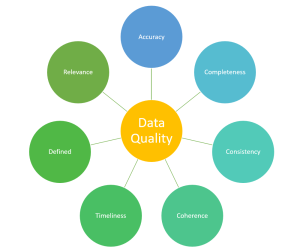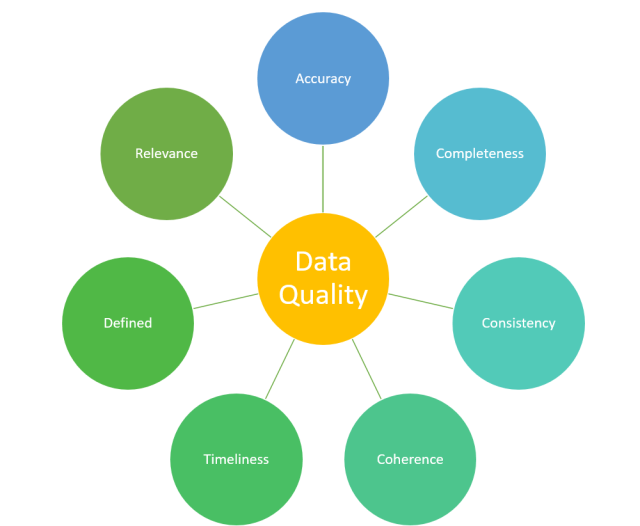
It is no secret that data is an essential component in the day-to-day operations of businesses—as well as the decision making processes. To ensure trust and reliability on the data, organizations must pay close attention to the quality of their data. In this blog post, we will discuss some of the key characteristics that make up quality data, diving into each characteristic and providing examples along the way.
Good data governance strategies are also essential for maintaining high quality datasets across an organization’s entire IT infrastructure. These strategies include quality control processes for entering new data into the system; establishing internal documents with procedures for validating all incoming information; assigning roles and responsibilities to staff members that are responsible for managing the quality of the data; and continual monitoring and auditing of existing datasets in order to detect any inconsistencies or discrepancies quickly.
The following are some of the key characteristics of high quality data:
- Data accuracy
- Data completeness
- Data consistency
- Data coherence
- Data timeliness
- Clear & accessible data definitions
- Data relevance
- Data reliability
Here is the visual representation of the attributes of high quality data set:
Data Accuracy
Data accuracy is an absolutely essential characteristic of high quality data, as it ensures that the information being collected and used for various purposes is reliable and trustworthy. Without accuracy, data can be skewed or misrepresented, leading to unreliable outcomes and potentially incorrect decisions being made.
Data accuracy is important in any domain where data is used to make decisions; from business analytics to medical diagnosis and beyond. For example, in the case of financial forecasting, inaccurate data can lead to faulty conclusions about the state of a company’s finances, which can lead to incorrect predictions about future performance. Similarly, inaccurate medical data can cause incorrect diagnoses or treatments for patients who might not be getting their best possible care.
The accuracy of data must also be maintained throughout its lifecycle, from collection all the way through storage and analysis. What are some of the techniques / practices one can adopt to achieve high data accuracy? There are a number of factors that contribute to achieving accurate data. Here are some of them:
- Firstly, it is of utmost importance to ensure that the data itself is correct; this means double-checking input values during collection or by validating entries against known standards or criteria before storing them in a database. It is always good to reduce handshakes before data is entered into the system. Also, it is very important to ensure high data accuracy in the source system. Fixing the data accuracy related issues in downstream systems can only be seen as temporary fix.
- Another key aspect for ensuring data accuracy is proper formatting of the stored values; this includes consistently representing numbers (e.g., using decimal points) and text strings (e.g., using consistent capitalization).
- It’s important to regularly audit stored values for correctness at each stage of their lifecycle to ensure they remain accurate over time; this could include running automated checks on new entries or manually reviewing existing ones periodically.
Data Completeness
Data completeness is another key characteristic of high quality data set. Data completeness means that all the necessary fields of information are present and accurate.
Data completeness is important for a variety of reasons. Here are some of them:
- Incomplete data can lead to inaccurate conclusions and decisions which can have serious implications for both businesses and individuals. For example, incomplete customer records can result in inaccurate customer segmentation, leading to inefficient marketing campaigns that target the wrong people. Incomplete datasets can cause systemic errors due to incorrect relationships between entities in a given dataset.
- Achieving data completeness requires resources such as time and labor costs associated with collecting additional information or double checking existing records for accuracy and consistency. Therefore, organizations should strive to achieve complete datasets whenever possible to minimize these costs.
- Complete datasets can help organizations make better decisions by providing them with comprehensive visualizations of their customers’ behaviors which enable them to uncover trends that would not be visible otherwise due to lack of actionable information.
Data Consistency
High quality data also requires the data to be consistent across different systems. Data inconsistency occurs when different values of the same data exist in different systems, which can result in incomplete or inaccurate information being presented. This kind of error can lead to significant losses for businesses as well as frustration among customers.
Inconsistent data can be caused by numerous factors such as manual errors, mistakes in databases or application code, incorrect handling on inputting or updating data, illogical coding rules or validation criteria on inputs etc. To prevent these types of errors from occurring, you should implement strict checks before any new data is entered into their systems and regularly audit existing records for accuracy.
Data Coherence
Many times, we need a coherent picture of data including the context. This is where data coherence comes into picture. Data can be termed as high quality data if it can be combined with other relevant data in an accurate manner. For instance, a purchase order (PO) should be able to be associated to a supplier, one or more line items in the order, a billing and/or shipping address, and possibly the payment information. That suite of information would provide a coherent picture of the purchase order. Coherence is driven by the set of IDs or keys that bind the data in different parts of the database together.
Data timeliness
Data timeliness is another key characteristic of high quality data. Data that is not current or up-to-date can lead to inaccurate results, outdated assumptions and incorrect decisions. This is especially true in fields such as business intelligence, finance, healthcare, marketing and analytics.
In today’s digital world, data changes rapidly and it is important for businesses to have access to accurate and current data in order to make informed decisions. Data that isn’t updated regularly can become obsolete or irrelevant due to changes in the market or other factors such as the new regulations. For example, a company having an access to sales revenue figures from the previous quarter would need to update those numbers on a daily basis if the business needs to track market trends and the performance of their competitors.
Data retrieved/generated in the timely manner helps organizations reduce risk associated with making decisions based on outdated information. Making decisions based on obsolete data can result in significant losses for a company due to missed opportunities or wrong investments made due to misinformed decisions.
Clear & Accessible Data Definitions
Having up-to-date data definition is a key aspect of high quality data, as it ensures that the data being recorded and analyzed is accurate, organized and well-defined. When information is accurately defined, it can be retrieved more quickly and easily accessed by relevant stakeholders. Having accurate data definitions prevent any misunderstandings or inaccuracies from creeping in when different stakeholders use different interpretations of the same piece of data. It also facilitates collaboration between teams and departments, ensuring everyone has access to the same set of information without having to worry about inconsistencies or misinterpretations.
Up-to-date definitions also help organizations avoid costly errors due to mislabeling or confusion over meaning. For example, if two people were trying to measure something like customer satisfaction but had differing interpretations of what constituted satisfaction, they could end up with conflicting results if they weren’t using an accurate definition of satisfaction.
Data Relevance
Data relevance is an essential factor in determining the quality of data. It refers to how pertinent the data is to a particular application or business purpose. High-quality data is invariably relevant to its intended use and contains only information that is necessary and appropriate for achieving desired results.
In basic terms, high quality data should be accurate, timely, complete and actionable – meaning it can be put into use or used to make decisions. To ensure these characteristics are met, it must be relevant and contain the right amount of information for the task at hand. This means including only those facts that are applicable and avoiding extraneous detail or unnecessary duplication of content.
The data relevance ensures accuracy by providing efficient access to the required information without any excess or irrelevant details which could obscure a decision or lead to incorrect conclusions. Without relevance, accuracy can suffer from distractions such as additional items that are misleading or without importance to the present context; this can lead to misdirection and suboptimal outcomes.
Data Reliability
Data reliability is an essential characteristic of high quality data. Reliability of data indicates the trustworthiness of the data source, ensuring that the data is accurate, timely, complete and consistent. Data reliability means that when information is collected from different sources or over multiple time periods, it should be consistent and produce similar results.
In order for data to be considered reliable, it needs to be accurate and up-to-date. This means collecting data from trusted and verified sources consistently over time in order to ensure that each piece of information has been collected accurately. It’s also important to regularly review the quality of the data collected and make any necessary changes or adjustments as needed.
Data reliability is also about being able to trust the consistency of your data across various platforms and systems. Data stored in different systems must be able to match up accurately in order for analysis and decision making processes to be effective and reliable.
Conclusion
Data quality characteristics are an essential part of working with datasets as they can help determine which datasets are reliable enough for use in decision making processes or business operations. Keeping these key characteristics in mind when dealing with datasets can help ensure trust and reliability which can ultimately save time by eliminating erroneous results from poor data quality management practices!
- Completion Model vs Chat Model: Python Examples - June 30, 2024
- LLM Hosting Strategy, Options & Cost: Examples - June 30, 2024
- Application Architecture for LLM Applications: Examples - June 25, 2024

Leave a Reply